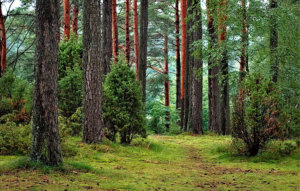What Makes a Forest Healthy?

Landowners always ask me is: “is my forest healthy?” While this seems like it should warrant a simple “yes” or “no” answer, the question almost always makes me pause, my eyes glazing over. Like many parts of our world, the deeper we dig into forests the less clear things become and judging if a forest is “healthy” or not is profoundly complex.
One of the many things that foresters are is scientists. As part of a scientific approach to management we want to use objective, measurable means to help us understand forests and how to take care of them. In school, one of the ways I was taught to define forest health was through the metrics of Acceptable Growing Stock (AGS) and Unacceptable Growing Stock (UGS). In forestry, an AGS tree is generally defined as one that may someday yield a sawlog (a higher-quality log that is sawn into boards) and has no obvious health issues that will kill it in the short-term. Conversely, a UGS tree is one which doesn’t meet those standards. By comparing the relative abundance of AGS trees to UGS trees, we can form an idea of how healthy the forest is.
The problem with AGS and UGS is that these metrics define forest health based on economic value and merchantability, parameters which have nothing to do how forests actually function. Some tree species, like hop hornbeam or beech, may never be AGS because there’s no market for them as sawlogs. Trees of these “non-merchantable” species, as well as trees that are dying, big, old trees and trees that are healthy but defective from a commercial perspective are “unacceptable” even though they may provide important habitats and support natural processes that are critical to forests.
As in this example, definitions of what a “healthy” forest is differs depending on who’s looking at the forest and what they’re looking for. If we see the forest solely as a resource to be exploited, measuring forest health based on economic parameters makes sense. If we see the forest as just a bunch of trees, measuring forest health based on how many trees appear to be healthy or unhealthy seems reasonable. But if we look at forests more holistically, neither of these definitions make any sense.
To truly understand what makes a forest healthy, we need to reimagine what a forest is. Forests are complex ecological communities which are defined by trees, but which also include a huge range of other stuff. Besides trees, what makes forests work are the interactions between trees, plants, fungi, bugs, reptiles, amphibians, birds, mammals and more, their environment, and natural processes over time.
Within this more holistic view, trees that we usually call “unhealthy” have important roles to play. Declining, dying and imperfect trees are host to a number of critical ecological processes; providing habitat, creating rich forest soil, storing carbon and supporting healthy hydrology, among other benefits. While healthy trees are an important part of healthy forests, and removing unhealthy trees to encourage healthier trees is an important part of responsible forest management, removing all unhealthy trees would result in the loss of these processes and habitats, which are critical to the health of the forest as a whole.
So, what makes a forest healthy? Increasingly, I define forest health using the word resilience. Instead of managing forests for stability – their ability to resist change – managing for resilience means supporting the forest’s ability to remain functional and vibrant while it changes. Resilience recognizes that forests are more than trees, that forests are dynamic, and that forests’ ability to change and adapt is what makes them truly healthy. Building resilience is especially critical today, as forests are forced to adapt at an unprecedented rate to an unprecedented array of stressors. This includes the myriad effects of climate change, non-native invasive plants, pests and pathogens, forest loss and fragmentation and more – the combination of stressors that we call global change.
The secret to resilience is managing for diverse, complex, whole forests and mitigating the factors that threaten their ability to become and remain diverse, like non-native invasive plants, deer overpopulations and forest fragmentation and loss. A precise definition for what a “healthy” forest is may continue to allude us, but by managing for resilience we can allow our forests to show us the way.
For more on building forest resiliency, click here.
Ethan Tapper is the Chittenden County Forester. He can be reached by email or by phone at (802) 585-9099. Sign up for his email list to see what he’s been up to.

